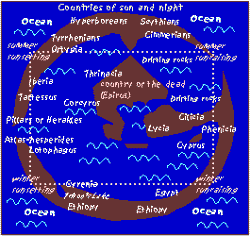| |
 |
 |
 |
|
The
imago mundi in archa´c Greece (Ballabriga, Les Fictions d'Homère,
Paris, P.U.F., 1998).
|
|
In his recent
book "Les fictions d'Homère, l'invention mythologique et
cosmographique dans l'Odyssée", Alain Ballabriga rejects
the point of view prevailing in the 1960'ies and the following years that
Odysseus' wanderings be purely imaginary and have no link with realities
of the ancient Mediterranean. He tries to show with historians whose research
field is archaic Greek colonization, such as Irad Malkin, that obvious geographical
aberrations found in the Odyssey are understandable if is assumed
that the East and the West are not only two opposed directions, but converge
like confines of a world known empirically. And to represent this world
known by archaic Greeks (7-6th century B.C.), Ballabriga draws its mental
map (map XX3). It appears that navigation from Greece to the East or to
the West, and reversely, follows routes previously known. On the contrary,
navigation north of a line connecting the summer West to the summer East
and navigation south of a line connecting the winter West to the winter
East exclusively concern figures of mythological countries: the sun, the
moon and the stars, Herakles, Jason and the Argonauts, the Hyperboreans
and the Aethiopians, the Ocean. The further one gets away from the central
zone of the Greek world and its colonies, the less sure is the empirical
knowledge that archaic Greek have of sea routes. Therefore, information
on these routes refers more to legend or mythology than to technique and
practice. 
|



